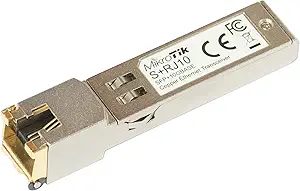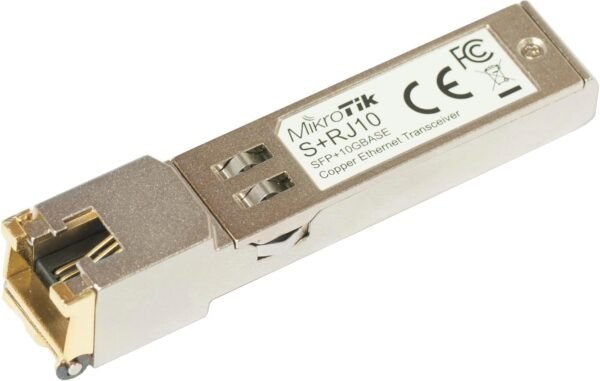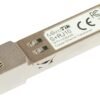MikroTik S+RJ10 Network Transceiver review high-speed performance and compatibility insights revealed
MikroTik S+RJ10 Network Transceiver review high-speed performance and compatibility insights revealed
- Effortless 10 Gbps speed upgrade using existing twisted-pair cables, eliminating the need for optical fiber.
- Seamless compatibility with active cooling devices featuring SFP+ ports for reliable performance.
- Exceptional durability with tested functionality in a wide temperature range, ensuring adaptability.
- Enhanced monitoring features like DDM support for tracking voltage and module temperature.
As an Amazon Associate I earn from qualifying purchases.
Description
Unboxing and Initial Impressions
The MikroTik S+RJ10 had me intrigued from the start. It’s not every day you find a module that promises up to 10 Gbps speeds over simple twisted-pair cables. The compact dimensions—just 2.68 x 0.63 x 0.59 inches—make it easy to handle and install. The build feels solid, and while it’s lightweight at 0.704 ounces, it doesn’t compromise on durability. The packaging was minimal but secure, giving me confidence that this product is meant to deliver without unnecessary frills.
I was particularly interested in seeing how it would handle jumbo frames up to 10218 bytes, a feature that stands out for users dealing with high-performance networking setups. The addition of DDM monitoring (supply voltage and module temperature) was also a pleasant surprise, hinting at the level of precision this device aims to achieve.
Ease of Installation and Compatibility
Setting this module up was a breeze. I simply plugged it into the SFP+ port of my MikroTik router, and it was ready to go. What made it even better was the absence of an optical fiber requirement. Just using RJ45 cables, I could immediately see the potential for upgrading my network to handle next-gen RJ45 hardware.
One thing to note is that while it works seamlessly with devices featuring active cooling, those with passive cooling might need extra cooling measures. I tested it on a passively cooled setup, and while it worked fine initially, the module did warm up slightly under a heavier load. This is definitely something to keep in mind if you’re planning on pushing it to its limits.
Performance and Real-World Usage
The performance of the module was nothing short of impressive. It consistently delivered on its promise of 10 Gbps speeds over distances of up to 200 meters. Testing it with various link speeds—100 Mbps, 1 Gbps, 2.5 Gbps, 5 Gbps, and 10 Gbps—showed accurate reporting in the interface menu, a significant improvement over earlier revisions of this product.
For someone like me who frequently transfers large files, the support for jumbo frames was a game-changer. The data flow felt smoother, and there were no noticeable bottlenecks, even when pushing the network during peak usage. The tested ambient temperature range (-20°C to 60°C) also speaks volumes about its reliability across different environments.
Key Benefits
- 10 Gbps speeds without requiring optical fiber installation.
- Compatible with a wide range of MikroTik devices featuring SFP+ ports.
- Enhanced features like jumbo frame support and DDM monitoring.
- Accurate link speed reporting, addressing a common issue in earlier models.
Areas for Improvement
While the module excels in many areas, there are a few considerations:
- Passive cooling setups may require additional cooling solutions during heavy usage.
- The module could get slightly warm under high workloads, which might be a concern for long-term reliability.
Design and Build Quality
The design of this module is simple yet effective. Its compact size ensures it doesn’t take up unnecessary space, and the RJ45 connector is robust enough to handle repeated use. The flash storage (256 KB) and tested compatibility with MikroTik’s RouterOS make it a reliable companion for advanced networking tasks.
The attention to detail, like including support for DDM monitoring, adds to its appeal. It’s also worth mentioning that it’s designed to handle extreme conditions—whether it’s freezing cold or sweltering heat, this module doesn’t back down.
Market Rivals
Comparing this product to others in the market, such as Cisco’s transceivers or Ubiquiti’s alternatives, reveals some interesting contrasts. While Cisco modules often come with a heftier price tag, the MikroTik option offers similar speeds and compatibility at a fraction of the cost. Ubiquiti’s products, on the other hand, are known for their ease of use but might lack the advanced features like jumbo frame support that this module brings to the table.
One area where the MikroTik module really shines is its plug-and-play simplicity. Unlike some competitors that require additional configurations, this one gets you up and running in minutes. However, in terms of cooling, Cisco’s active cooling solutions seem slightly more efficient, especially for intensive tasks.
Cost Efficiency
Considering the features it brings, this module offers exceptional value for money. You’re essentially future-proofing your network with 10 Gbps speeds without the need for expensive optical fiber installations. Its performance, combined with the reliability of MikroTik’s hardware, makes it a smart investment for both professionals and tech enthusiasts.
For anyone looking to upgrade their network without breaking the bank, this module strikes the perfect balance between performance and affordability. While there are cheaper alternatives, they often lack the robust feature set and reliability this one provides.
Additional information
| Wireless Type | 802.11ac |
|---|---|
| Brand | MikroTik |
| Series | S+RJ10 |
| Item model number | S+RJ10 |
| Operating System | RouterOS |
| Item Weight | 0.704 ounces |
| Product Dimensions | 2.68 x 0.63 x 0.59 inches |
| Item Dimensions LxWxH | 2.68 x 0.63 x 0.59 inches |
| Manufacturer | MikroTik |
| Is Discontinued By Manufacturer | No |



